06.08.2013: I’m back from my summer vacation, having spent three weeks in Canada and the US. We started by flying from Zurich to Chicago. In Zurich they extended the lounge in dock E with an outside deck, which is great if you are a bit early and want to watch planes. Below a picture I took from my favourite plane, the A380 from Singapore Airlines, which I have taken several times when flying for my job to Australia.

In Chicago we rented a car to do a tour around Lake Huron and Lake Superior. We tried to spend as much time as possible in National and Provincial Parks, doing some hiking. We spend most nights in our tent, except for three or four nights when the weather was too bad. Below a typical campsite somewhere in Canada. To our surprise there were very few tourists.
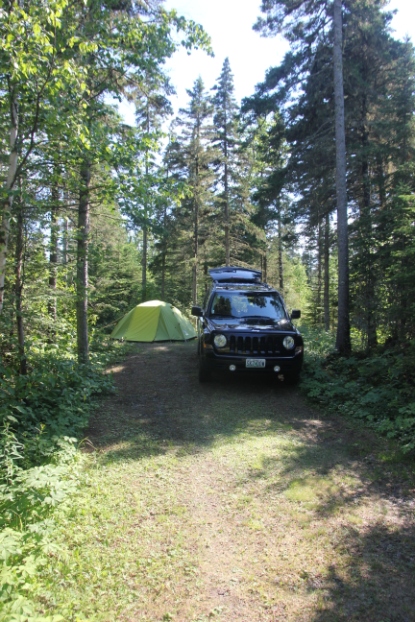
Lake Superior is a quite rough place, with a pretty harsh climate in winter and cool summers. During some nights the temperature dropped to around 8 degrees C, maybe that’s why there were so few tourists.
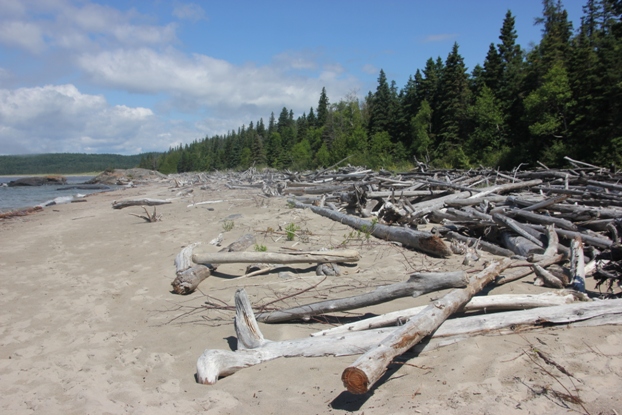

We saw quite many animals, including beavers and moose, and also bears.


We also saw quite a few floatplanes. It’s my dream to build one as my next project, but I must figure out fist how I can finance it.

In Sault Ste.Marie we visited the Canadian Bushplane Heritage Centre, a museum dedicated entirely to floatplanes, bush planes and their operation in developing the North of Canada and in forestry protection. What makes the place special is that you can go there with your own seaplane, as they have a ramp to the St. Mary’s River. Below what looked like a brand new Maule in front of the museum.

The museum exhibition includes around 30 floatplanes, bush planes and waterbombers, as well as many artefacts from the early days of bush flying in Canada.

Some of their planes are in flying condition, such as the De Havilland DHC-2 Beaver below,…

…as well as the De Havilland DHC-3 Otter.

My wife preferred the Canadair CL-215, as there would be enough space in it to convert it to a camping vehicle. I just fear that the fuel consumption is a bit higher than the one of my SportCruiser, probably around 800 – 900 litres per hour, compared to my 17 litres per hour .

On the way back to Chicago we stopped in Oskkosh for AirVenture, the annual fly-in convention of the Experimental Aircraft Association, of which I am a member since many years. For those who don’t know it, AirVenture is a one-week event, which usually attracts more than 10’000 planes and more than 500’000 visitors over the course of the week. Many visitors come for the daily airshow, but there is a full program of exhibitions, seminars, workshops and evening programs. I have been to AirVenture before, but it’s always great to come back.
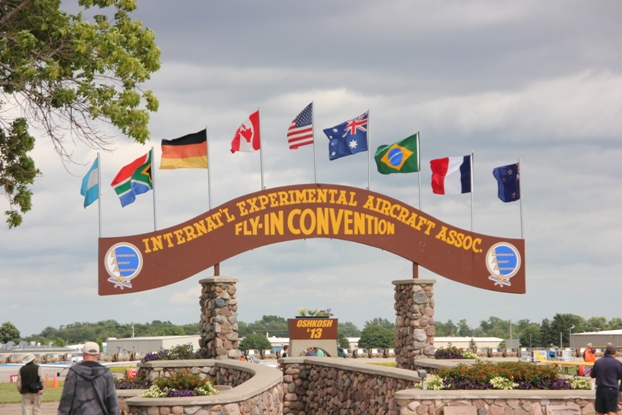
During the convention Wittman Regional Airport, where everything takes place, is the busiest airport in the world in regard to aircraft movements.

We arrived on Sunday afternoon, the day before the event officially starts, but there were already lots of planes arriving. We were just sitting at the edge of the runway, watching the steady flow of planes landing (maybe one every 20 seconds) and admiring how the whole thing is organised. Below a picture where seven or eight planes are on final to the same runway at the same time. They let them land on different spots along the runway, which are painted in bright colours for good visibility, so that they can essentially have three planes touching down at the same time.

Below a picture of what the aircraft parking looks like, and that’s just one of several parking areas. Planes are grouped according to the group they belong to, such as experimental aircraft, warbirds, vintage planes, seaplanes etc.
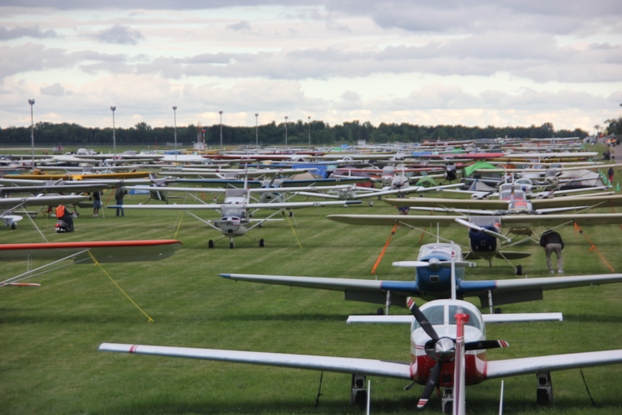
While we were sitting at the runway a Catalina arrived, which would also be a nice (and expensive) toy…

.. as well as a Grumman Widgeon, which is probably a more realistic dream.

Later I saw many more Widgeons, as well as many other seaplanes.
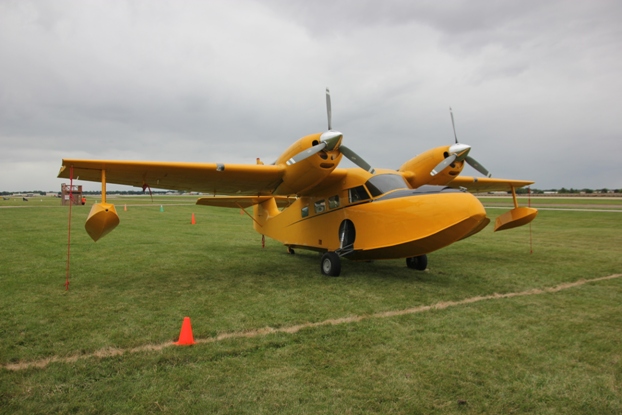







There is also a seaplane base on nearby Lake Winnebago. They are running a regular shuttle busses between Wittman Regional and the Seaplane Base, so getting there is easy.

Compared to the busy main venue the seaplane base is a place of tranquility.
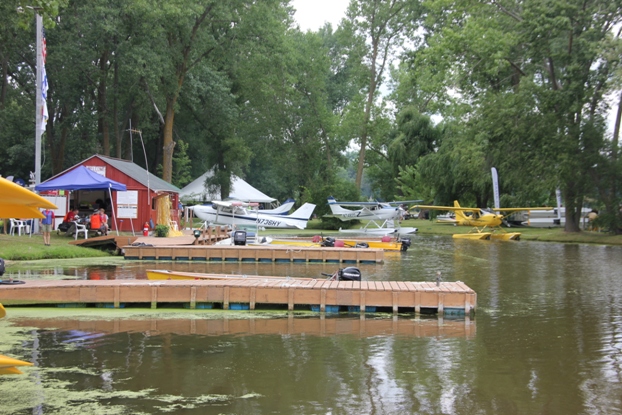
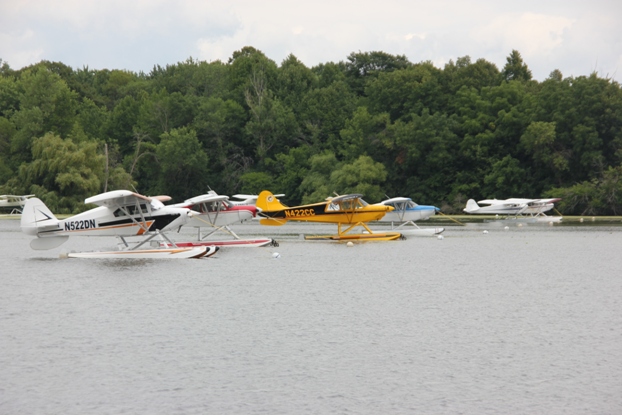
I even saw a homebuilt biplane seaplane, which was on sale for around 25’000 $, quite tempting. I just doubt it has the range to be flown home.

In one corner I saw an old Czech Jawa bike with a side car,…
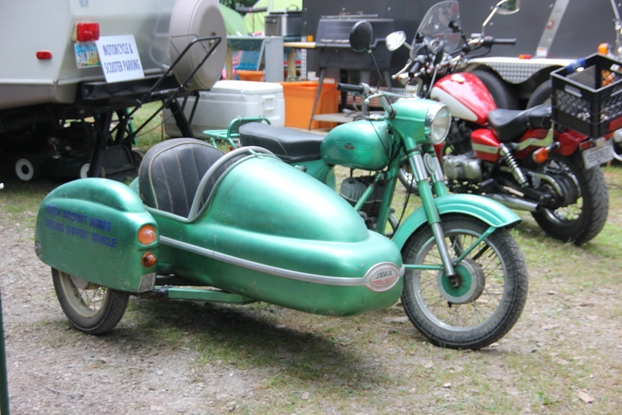
… with a surprising marking on the side: “Czech Aircraft Works Ground Support Vehicle”. My SportCruiser kit was manufactured by Czech Aircraft Works!
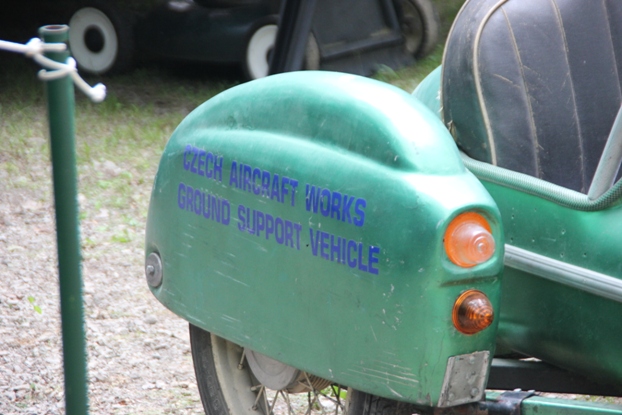
One evening there was a panel discussion on the past, present and future of manned spaceflight, with four former astronauts participating. The guy on the left is Chris Hadfield, who returned two months ago from a five months stay as commander in the International Space Station. He’s the one who did the funny Major Tom video, a must to see on YouTube (http://www.youtube.com/watch?v=KaOC9danxNo). The guitar is by the was still up there. The guy on the right is Gene Cernan, the last man on the moon. It was a very funny evening, with the astronauts telling a lot of small, personal anecdotes from their flights.

Another evening there was a presentation from the guy who managed to secure the Space Shuttle Endeavor for the Los Angeles Science Museum, and how they managed to get it to the museum over a 19 km route over public roads. It was a great evening again, but the best was the document he showed that confirmed the transfer of ownership of the Shuttle from NASA to the museum. It is the same form they are using for selling off e.g. an obsolete copying machine, with the subject to be transferred being a “Space Shuttle Endeavour” and with an initial value listed as somewhere around 1.8 billion US$.

I spent a full day visiting the exhibition area, where everything can be found from business jets to spare parts for vintage aircraft. One of the first booths I visited was off course Czech Sport Aircraft, the manufacturer of the SportCruiser, who had two aircraft on display.

One manufacturer presented a kind of” road-conversion” for the Glasair Sportsman, where they changed the main landing gear to a steerable gear, and attached a small engine to the rear fuselage, which drives a single rear wheel.


Garmin introduced their new line of non-certified avionics for amateur build and light sport aircraft, an area in which they were so far poorly represented with the exception of radios and transponders. They system they developed is similar to the Dynon SkyView, with multiple screens that can exchange data over a bus system.

Of course we also went to see the daily airshows. The main difference to other years was the complete absence of all military aircraft, as well as of all government agencies such as FAA, NASA etc. due to the sequestration of the US budget. This did however not really disturb, as military aircraft were never a key part of AirVenture. Below a few impressions from the airshow:



Honda demonstrated for the first time their new business jet, and on top pf that not only the prototype but also the first one produced in the final configuration. And to top that they did a tandem demonstration, something I haven’t seen before with business jets.
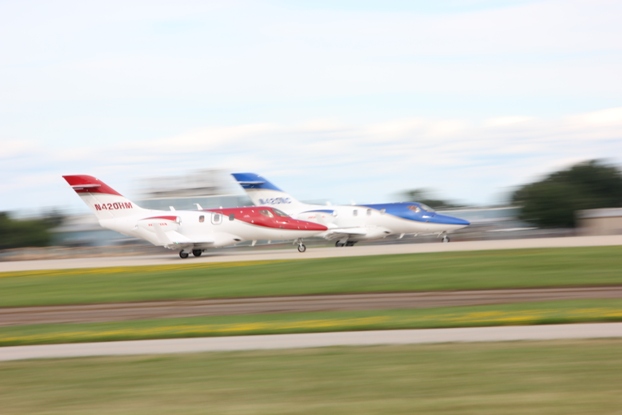

For the more budget conscious (or constrained) there were a number of smaller jets on display, such as this quite old Bede BD-5 (the type that flew in one of the Bond films)…

…as well as the brand new SubSonex Personal Jet, which is available as kit!.

To promote the new Disney film called “Planes” there was even an agriculture plane painted in the same colours as the hero of the film. They actually showed the film as a pre-premiere on one of the evenings, but that was after we had left.


I said before that there were no military planes, but there was one exception, a privately owned (!!) Harrier Jet. I love seeing it take off and land vertically, it’s just plane amazing (and amazingly noisy as well…).
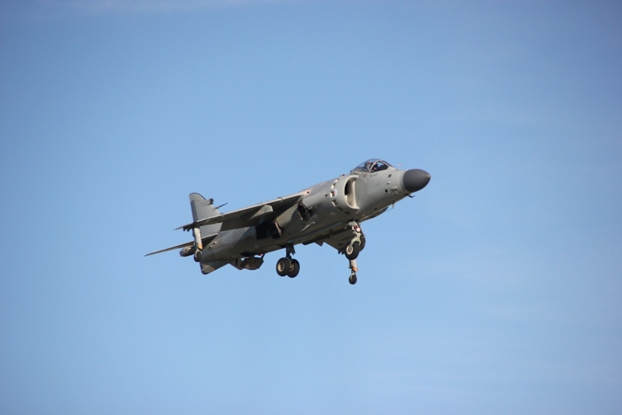
There was even a Swiss participation in the airshow, Ives Rossy with his strap on jet powered wings. He jumped with if from a helicopter and did quite a long flight demo, with loops and high speed passes, but all of that quit high up as has to land in the end with a parachute….

…as can be seen here.

One of the demonstrations that was more than just aerobatics, and gained quite some attention, was the Terrafugia Transition flying car. It has flying performances similar to many light sport aircraft (it is also powered with a 100 hp Rotax, like most of them)….

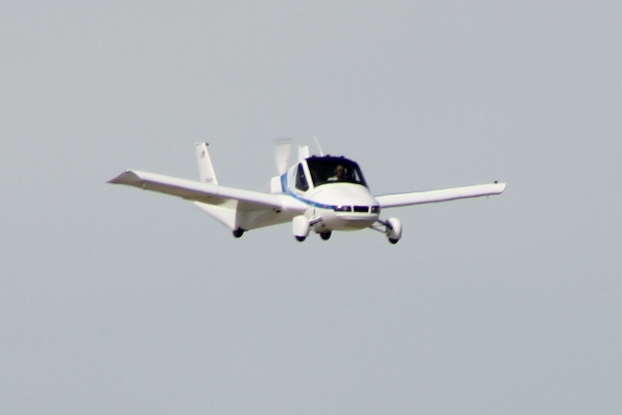
…but one it has landed it can fold up the wings and drive as a normal car on public roads.
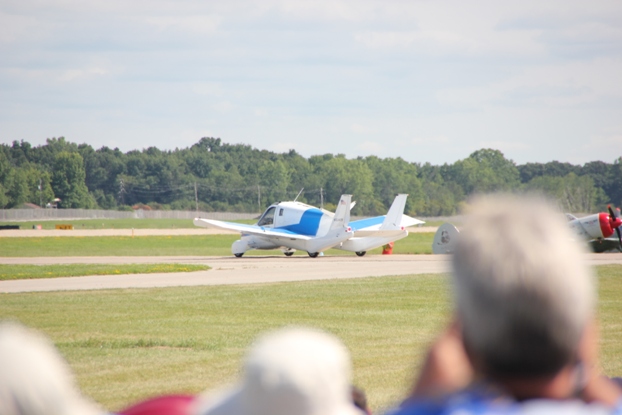
Below a sequence of pictures showing how the wings fold. This is done at standstill, with the engine switched off, but happens fully automatically so that the pilot / driver does not even have to leave the cockpit / cab.
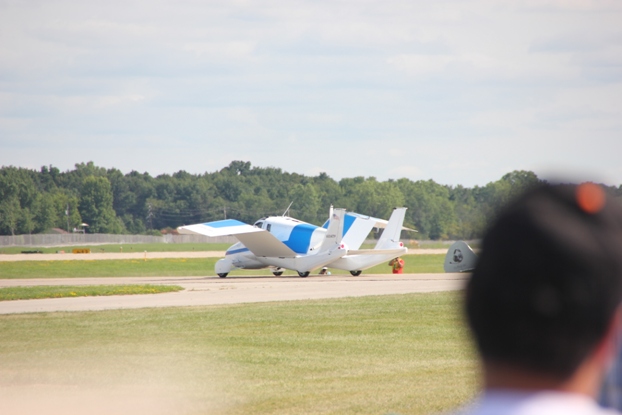

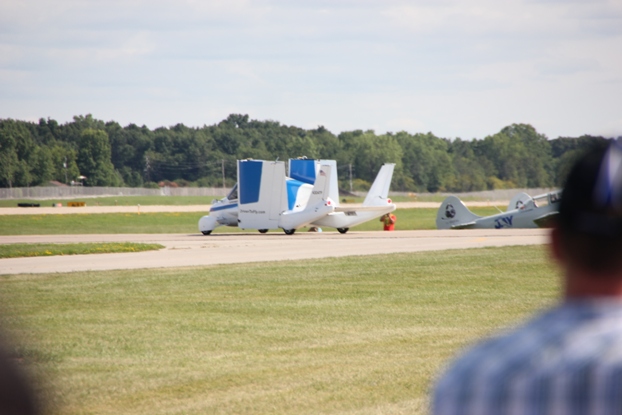
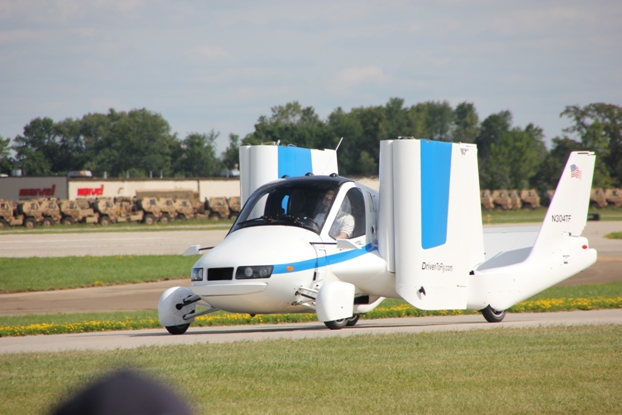
It’s for sure cool to be able to fly and to drive, but even the smallest parking accidents can be very costly, immediately making the “thing” not airworthy. So I wonder whether this specific version of a flying car will be successful.
One evening there was even a night airshow, which started at dusk and lasted until it was completely dark. Again a few impressions of the program below.
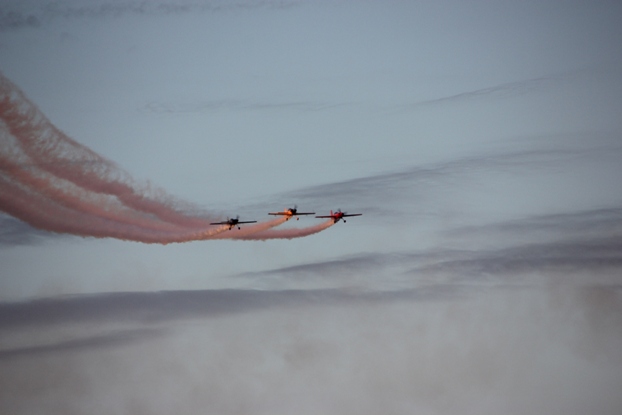



On the last day we went to see the EAA museum, which has an impressive collection, such as the first prototype of the spacecraft with which Virgin is planning to offer public space rides.
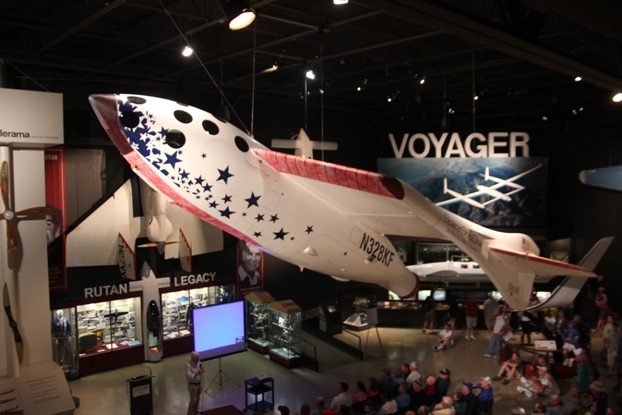
Conclusion: we had a great time in Oskkosh and saw a lot of new things both in the exhibitions and the airshow.
From Oskosh we returned to Chicago, where we spent two night before flying back to Switzerland, arriving home on the 6th August.
17.08.2013: As it was to be expected I did not get a chance to go flying soon after returning from our holidays. Quite a lot of work has piled up during those three weeks of absence. Yesterday we managed however to visit friends who live around 200 km from where we live, near Grenchen AIrport (LSZG). I had promised their kids since quite a while that I would go flying with them, and as it was perfect weather (blue sky and more than 25 degrees C) we went there by plane.
After arriving in Grenchen I went flying with the kids, but then the parents decided they want to go flying too so finally I did four passenger flights on top of flying from Lommis to Grenchen. The result was about the same flying time in one day as flying from Switzerland to Denmark. We then stayed overnight with our friends, flying back this morning. Once more it proved to be a great advantage to have a fuel capacity of nearly six hours. I filled the tanks before we left Lommis and did not have to worry about refuelling for the whole weekend.
When we were back I also did a test flight with a plane we are looking at as a new trainer for our club fleet (Aquila A211). We will also look at others during the next few weeks.
25.08.2013: This weekend we had the annual fly in of the Experimental Aviation of Switzerland (EAS). It wasn’t an ordinary fly-in, as the organisation turned 50 this year. Unfortunately, the weather was terrible, bad luck. The flight to the event, which took place in Grenchen (LSZG) was still ok…
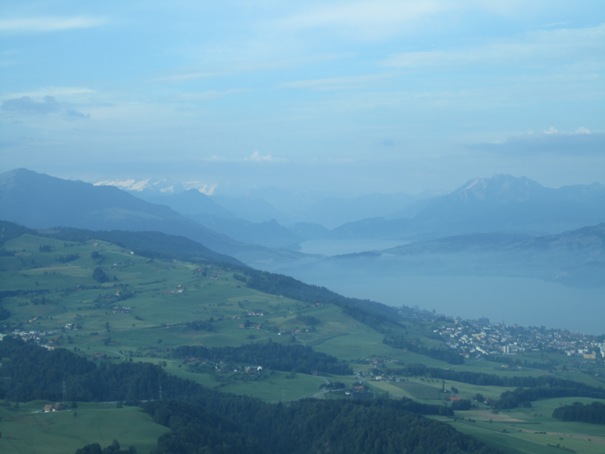
… and quite many planes attended.


Below a German light plane with an fully exposed cockpit, definitely not the right plane for poor weather.

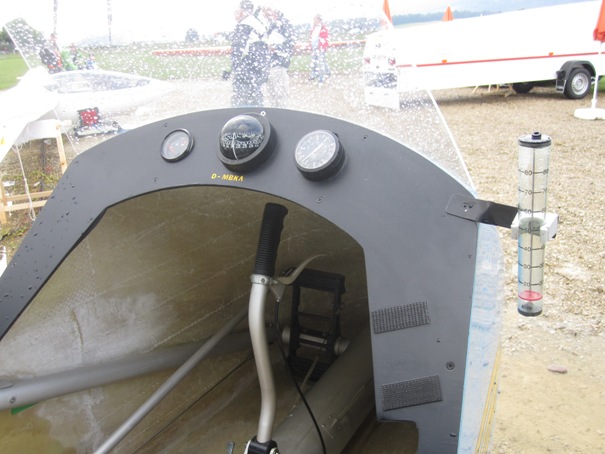
Here some details of the plane, what I did not like is the pilot and passenger seat, which also serve as a fuel tanks. I’m not sure this would pass any kind of safety assessment.

Also the air speed indicator seems pretty primitive, but I guess it works.

There was also an electric powered aerobatic glider.
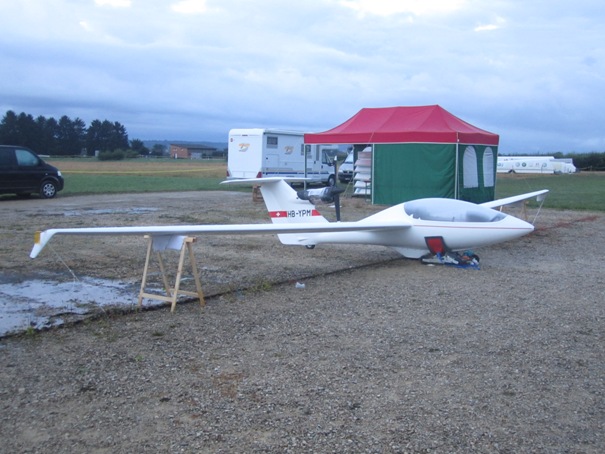
As can be seen below there was a lot of rain, flooding some parts of the airfield.
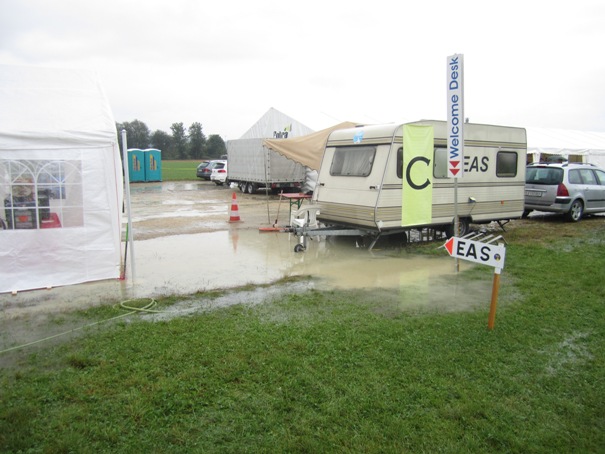
Some builders seem to have forgotten to install tie down hooks, and also seem not to know that the tie down hook, the tie down rope and the anchor should match to a certain extent. Wrapping a small thread around the wing tip strobe and tying it to an oversize nail seems kind of unbalanced.

The 50th anniversary of the EAS was celebrated with guest from even the FOCA and local politics, luckily they had organised a tent as it was continuing to rain.
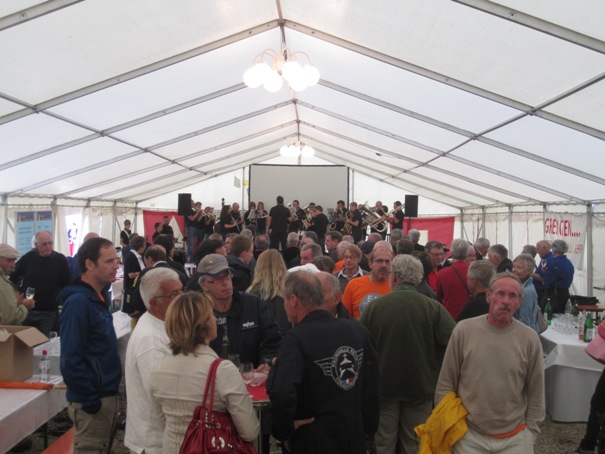
The flight back was ok, under a low cover, but no problem.


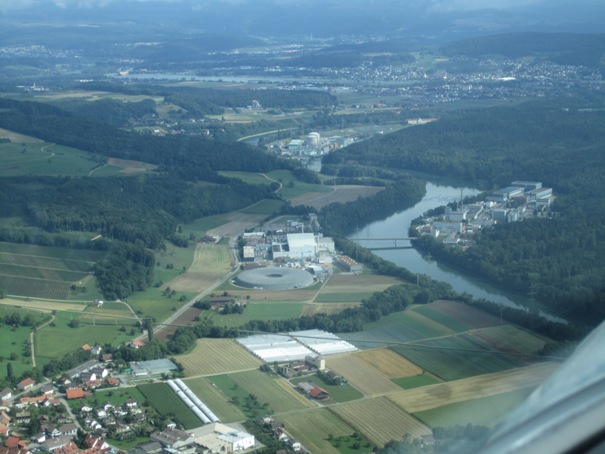

A fellow club member and homebuilder, whose plane is not yet finished, participated with the club’s SportCruiser, flying home at the same time as me.

30.08.2013: Today I had to attend a one-day training organised by the Experimental Aviation of Switzerland but required by our Federal Office of Transport (including a test at the end). It was about Continuing Airworthiness Management for Homebuilt Aircraft.
Until now the builder of an aircraft could do any kind of maintenance on his aircraft without any formal approval, just because he was the builder. In the future he will be given a licence to maintain his own aircraft to the extent he can demonstrate knowledge, for this he will even be issued a registration number. Work might exclude e.g. engine overhauls (which hardly anybody does anyway), but on the other hand also a buyer of an experimental aircraft can obtain such a licence.